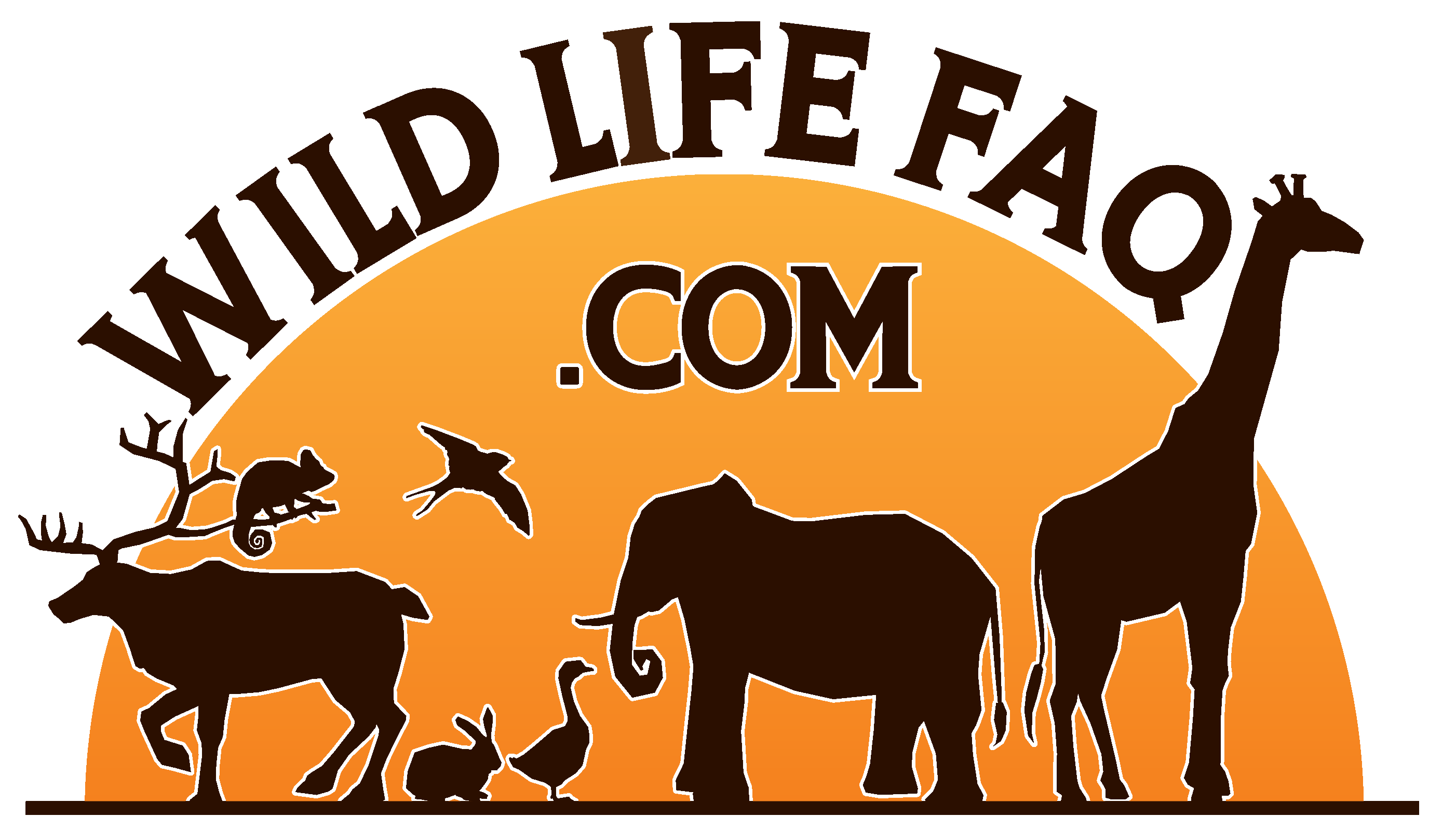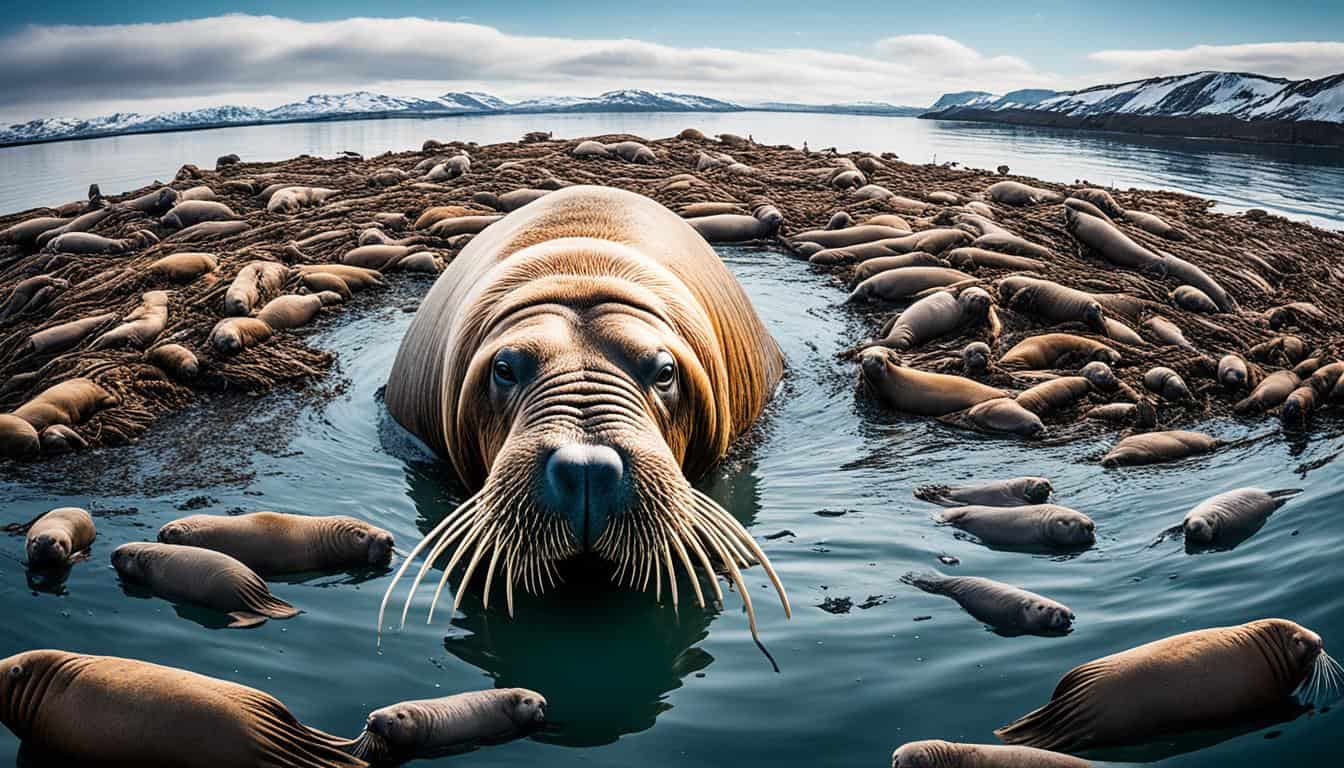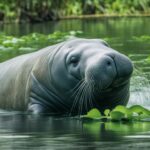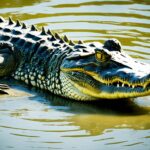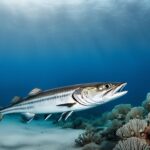Walruses are amazing marine mammals that are key to Arctic ecosystems. But, they are facing big threats that could harm their survival. It’s important to know what threats walruses face to help protect them. We will look at the dangers like climate change, losing their homes, more human activity, and being hunted.
These threats lead to a worrying decline in walrus numbers. This has made people talk about the need for action and awareness. We want to tell you why it’s crucial to save their homes and protect them.
Understanding the Walrus: An Overview
Walruses, known scientifically as Odobenus rosmarus, are fascinating creatures. They play a key role in their ecosystems. This section will cover their unique features, like their habitat and physical traits. It will also look at their behaviors in the Arctic marine world.
Scientific Classification and Habitat
Walruses are part of the family Odobenidae and the pinniped group, which includes seals and sea lions. They live in the cold Arctic, mainly in the Bering Sea and nearby areas. These places give them what they need to survive and reproduce.
Physical Characteristics and Behavior
Walruses have distinct physical traits that show how well they adapt to their environment. Adults can be 7 to 11 feet long and weigh up to 3,700 pounds. They are known for their long tusks, which can reach up to three feet long. These tusks help them make breathing holes in ice and get out of the water.
Walruses are social animals, often living in large groups called herds. These herds can have hundreds to thousands of members, offering safety from predators. They mainly eat bottom-dwelling invertebrates, playing a crucial role in the Arctic ecosystem.
| Attribute | Description |
|---|---|
| Scientific Classification | Order: Carnivora, Family: Odobenidae, Species: Odobenus rosmarus |
| Habitat | Primarily found in the Bering Sea and Arctic Ocean |
| Size | 7 to 11 feet in length |
| Weight | Up to 3,700 pounds |
| Tusks | Can grow up to 3 feet long, used for various purposes |
What threats do walruses face?
Walruses are facing many threats that put their survival at risk and lead to a decline in their numbers. The main issue is the walrus population decline, mainly caused by climate change. Rising temperatures make their sea ice home disappear fast. This forces them to come onto land, where they face dangers from humans, other animals, and getting trampled.
The climate change effects on walruses go beyond just losing their home. It also changes their food supply, making it harder to find. When they can’t go to their usual places to find food, they’re more likely to run into humans. This increases the danger from hunting, ships, and industrial activities.
Humans are also a big problem for walruses. Things like oil and gas searches harm their homes and can pollute where they find food. All these problems make walruses more vulnerable. They’re struggling to adapt to the big changes happening around them.
Climate Change and Its Impact on Walruses
Climate change is a big challenge for walruses. The decline of sea ice affects their survival. Sea ice is crucial for their survival, as it’s where they give birth, nurse their young, and rest.
The Role of Sea Ice in Walrus Survival
Sea ice is key to walruses’ lives. They use it for:
- Resting between dives
- Nursing their calves
- Foraging for food
Climate change makes it harder for walruses. They swim further to find food, leaving young ones at risk. The melting ice makes it hard for walrus populations to grow.
Behavioral Changes Due to Climate Shifts
Climate change has changed walrus behavior. Some changes include:
- Altered migration patterns due to shifting ice formations.
- Increased competition for food resources as prey availability changes.
- Variations in social structures within walrus herds.
These changes make walrus populations unstable. Walruses adapt, but not all changes help them. Climate change’s effects on walruses are a big worry for their future.
| Factor | Impact on Walruses |
|---|---|
| Decline of Sea Ice | Increased distance for feeding, jeopardizing calves’ safety |
| Temperature Rise | Altered migration and feeding behaviors |
| Changes in Food Availability | Intensified competition amongst walrus populations |
Walrus Habitat Loss
The walrus population is facing big challenges due to habitat loss. This is mainly because of climate change and the less sea ice. As sea ice melts, walruses have to change their homes and paths.
Effects of Diminishing Sea Ice
Less sea ice is a big problem for walruses. They lose important places to rest and breed. This makes them gather in crowded and dangerous spots.
This change can make walruses stressed and increase death rates, especially for young ones. They also move closer to people, which can lead to more problems.
Challenge of On-shore Hauling
On-shore hauling adds more trouble for walruses. They have to come onto land instead of ice, facing more dangers. This includes being eaten by predators and being bothered by people.
These groups on land can cause panic and lead to serious injuries or deaths. The loss of safe places makes it hard for walruses to survive.
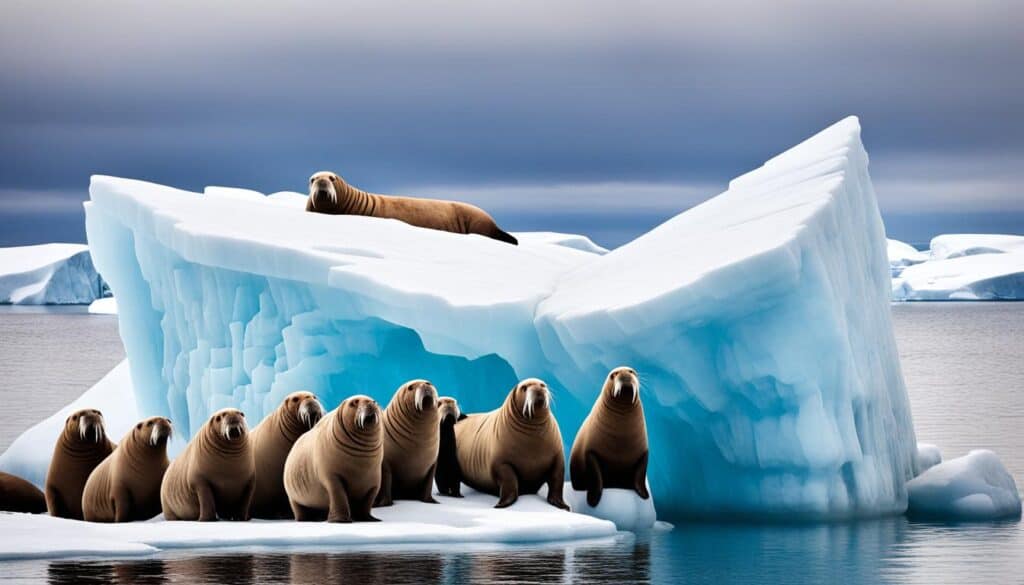
Human Impact on Walrus Populations
Human activities greatly affect walrus populations, making their future uncertain. As the Arctic warms up, more people can access these areas. This leads to more ships and industrial work that harm walrus homes.
Increased Marine Traffic and Industrial Activity
More ships threaten walrus survival. Ships make too much noise, which can mess with walrus communication and make them stressed. These ships often go through areas where walruses live and travel, causing them a lot of trouble.
- Disturbance of breeding grounds
- Increased competition for food resources
- Potential collisions with vessels
This mix of problems hurts walrus numbers a lot. We really need to think about how we move through the ocean to help them.
Impact of Oil and Gas Development
Oil and gas work also poses big risks for walruses. When companies explore and extract resources in these areas, they can damage the environment and spill oil. A small spill once had a big effect on the sea life, making walruses move away.
| Impact Type | Description | Potential Consequences |
|---|---|---|
| Oil Spills | Release of oil into the marine environment | Contamination of feeding grounds, reduced prey availability |
| Noise Pollution | Excessive noise from drilling activities | Disruption of communication and breeding behaviors |
| Habitat Loss | Destruction of key sleeping and breeding sites | Population decline due to loss of suitable habitats |
We need good plans to lessen our impact on walruses. This will help ensure a future for these amazing animals.
Predation and Competition in Walrus Ecosystems
Understanding walrus populations means looking at how they face predators and compete for food. These factors greatly affect their survival and behavior in their habitats.
Natural Predators of Walruses
Polar bears and killer whales are the main predators of walruses. Polar bears target young or weak walruses. As the climate changes, these predators move into areas where walruses rest, making them more vulnerable.
Killer whales also threaten walruses with their smart hunting methods. This makes walruses change their behavior and social groups to stay safe.
Competition for Food Resources
Walruses eat mainly benthic invertebrates like clams and mollusks. Changes in the ocean affect how much food there is, making walruses compete more. With more commercial fishing, they also face competition from other sea creatures.
This competition makes it harder for walruses to find enough food, affecting their survival in a changing world.
| Predator | Impact on Walrus |
|---|---|
| Polar Bears | Targets weak or young walruses, altering their haul-out behavior. |
| Killer Whales | Employs complex hunting strategies, affecting walrus population dynamics. |
Knowing about these threats is key to saving walrus populations and keeping their ecosystems stable.
Walrus Hunting Practices
The history of hunting walruses is deep and tied to the culture of Arctic indigenous communities. For thousands of years, these communities have seen walruses as a key food source. They use their blubber, meat, and tusks for many needs. This tradition shows a deep bond with the land and sea.
It also shows the value of traditional hunting methods passed down through generations.
Historical Context of Walrus Hunting
It’s important to understand the history of walrus hunting to see the big conservation issues today. Hunting walruses was once sustainable, but climate change and industrial growth are now threatening their numbers. Today, hunting must balance cultural importance with the need to protect walruses.
This balance is key to protecting walruses for the future. It’s clear that respecting indigenous rights and using their knowledge in conservation is essential.
Now, the environment is challenging for both conservationists and indigenous groups. As walrus habitats shrink and ecosystems change, we must talk about the past and present of hunting. This dialogue is crucial for solving conservation problems and keeping cultural practices alive for future generations.
FAQ
What are the main threats faced by walruses today?
Walruses face threats like climate change, which causes habitat loss and more human activity. These threats lead to a decline in their numbers and harm their homes.
How does climate change specifically affect walrus populations?
Climate change makes sea ice disappear, which walruses need for giving birth and nursing. Without ice, mothers swim far to find food, leaving young ones in danger.
What are the consequences of habitat loss for walruses?
Losing their habitat puts walruses at risk on land. They face human disturbance, predators, and trampling. This leads to more stress and death, especially in young ones.
How do human activities impact walrus populations?
Humans increase marine traffic and industrial work in the Arctic. This harms walrus homes and causes noise pollution. It changes their behavior and eating habits, threatening their survival.
Who are the natural predators of walruses?
Polar bears and killer whales prey on walruses. They compete for food in a tough ocean environment. This affects walrus numbers and how they live.
What is the historical context of walrus hunting among indigenous cultures?
Indigenous people have hunted walruses for a long time. It’s important to them. But, it’s hard to balance hunting with protecting walruses for the future.
What conservation efforts are in place for walruses?
Efforts include protecting their homes, controlling hunting, and spreading awareness about climate change. Working together is key to saving walruses.
